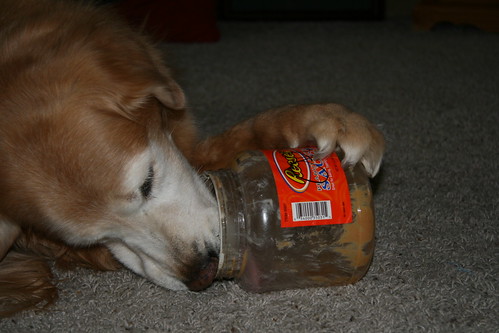 Note: I did not go to Vet school and I'm not giving medical advice. For informational purposes, and because I like to research numbers, I'm sharing here some canine heartworm medication dosages along with sources for that information. If you have any questions about the medication you are giving your dog or if you want to make a change to the dosage, please ask your Veterinarian.***
Note: I did not go to Vet school and I'm not giving medical advice. For informational purposes, and because I like to research numbers, I'm sharing here some canine heartworm medication dosages along with sources for that information. If you have any questions about the medication you are giving your dog or if you want to make a change to the dosage, please ask your Veterinarian.***Heartworm drugs kill certain stages of heartworm larvae which may have developed in the dog's bloodstream over the previous 30 days. This is commonly referred to as "heartworm prevention" although that is rather a misnomer. Perhaps it would be more accurately termed "prevention of heartworm larvae developing further". The two most common heartworm drugs are Ivermectin and Milbemycin Oxime.
The
minimum dosage of Ivermectin for heartworm prevention is 6 micrograms (mcg) per kilogram (kg) of body weight, every 30 days. For us non-metric-enians, that's 2.72 mcg per pound (lb) body weight.
Some brand names of FDA approved Ivermectin tablets which your Vet may sell or you might order online are
Heartgard (or Heartgard Plus which adds an intestinal dewormer to the Ivermectin),
Tri-Heart Plus (Ivermectin plus intestinal dewormer), (
Note: Tri-Heart got into some trouble with the FDA in 2007 over their claim of the product's effectiveness against whipworms) and
Iverhart who offers two products - both containing Ivermectin plus intestinal dewormers.
Rather than manufacture and market dozens of different products for various weights of dogs, pharmaceutical companies typically market just a few products, each one with a range of weights to be treated. For example, a product labeled "for dogs up to 25 pounds" contains the Ivermectin needed for a 25 pound dog. All dogs weighing less than 25 pounds are receiving more than the minimum Ivermectin necessary for heartworm prevention.
In order to dose specifically for the weight of an individual dog, some owners opt to purchase the 1% Ivermectin solution injectable labeled for cattle and dilute it with a suitable liquid (Ivermectin does not mix evenly with all liquids which would throw off the dosing) such as propylene glycol. Or you could
purchase the Ivermectin already diluted. The 1% Ivermectin solution contains 10mg (10,000 mcg) per ml. (Note: 1ml=1cc) Diluted to .05% (a 1/20th dilution), each ml contains 500mcg. Looking at
Chart A, a 50 pound dog needs a minimum of 136mcg of Ivermectin. Using the diluted solution, that would be about .27 of a cc given orally - not injected. Clearly a tuberculin syringe would be needed to measure this dosage. Alternately, the 1% Ivermectin solution could be
diluted further.
Note: Many Vets discourage this "off label" use of the cattle version of Ivermectin in dogs as it is not FDA approved. Vets are obligated to advise their clients to use the FDA approved versions of canine heartworm meds on the market - that doesn't mean it's unsafe.
The lethal dose for Ivermectin is 10mg/kg in rats. This is a huge dose. Super huge. In other words, Ivermectin is a very safe drug (unless your dog happens to be sensitive to it).
Which brings me to my next topic: opting to give your dog more than the minimum required dose. Many people choose to give more than the minimum Ivermectin dose:
- Those who like the convenience of purchasing the medicine in a dose for the top of the weight range but whose dog weighs less
- Those who add the diluted Ivermectin liquid to the dog's food and don't want the worry of "What if a minuscule amount got left in the food bowl and my dog got shorted?"
So how much more than the minimum is proven safe to give on a monthly basis? To answer that conservatively, we can look at the bottom weight range in the pre-packaged Ivermectin tablets. For example, if you follow the package instructions for a 51 pound dog, you are giving approximately twice the minimum required Ivermectin each month. Same for a 26 pound dog - the label instructs you to give one tablet monthly and that tablet contains approximately twice the amount needed for the dog's weight. So the manufacturers and the FDA have approved routine monthly dosing of twice the minimum required amount of Ivermectin for dogs. If you are curious about giving more than twice the minimum dosage monthly, check with your Veterinarian.
***The other drug commonly used for heartworm prevention is Milbemycin Oxime and is marketed under the brand name
Interceptor as well as others. This drug is administered to dogs at a dose of
0.5 mg/kg body weight (.23 mg/lb) every 30 days. At this dosage, the drug works against heartworm and intestinal parasites. If you are wanting to use the drug for heartworm prevention
only, you'll want to use the "
Safeheart dose". (Safeheart was approved by the FDA in 1998 but never sold in the US.) The FDA states:
This supplement provides for a change in dose for dogs from a minimum of 0.5 mg/kg [which is the Interceptor dose, which also controls intestinal parasites] to a minimum of 0.1 mg/kg with a corresponding restriction in indications to the prevention of heartworm disease only. [bracketed addition=mine]
Interceptor is packaged in the following dosages: 2.3mg tablets, 5.75mg tablets, 11.5mg and 23 mg tablets. Looking at
Chart B, the 2.3mg tablet would be the right dosage for a 45 pound dog if you wanted heartworm prevention ONLY. If your dog weighs less than 45 pounds, I don't know of any options for purchasing smaller doses of Milbemycin Oxime in the US.
Splitting pills is one alternative some people use with due care.
Further reading:
Dr. Khuly's pitch for doing your "civic duty" and giving your dog heartworm meds
Dr. Khuly writes about a few of the reasons owners don't give heartworm meds when they really should



















